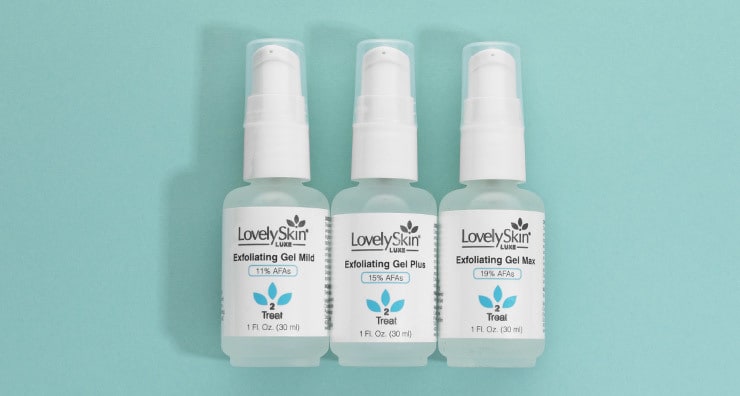
About the Author
Jill is a content writer for LovelySkin. She loves reading up on the latest beauty trends, going to concerts with her husband and baking with her three kids.
Other Posts by JillWelcome to LovelySkin.com.

For decades, we’ve been hearing about the importance of using skin care products that are pH balanced for skin. But what does that mean? The relationship between skin health and pH levels in the products you use is interesting, but somewhat complicated. We’re here to simplify and explain pH in skin care, why it matters and how you can still achieve a glowing complexion while keeping your skin’s pH balance in mind.
pH, which is shorthand for potential of hydrogen, measures the activity of hydrogen ions in a water-based solution. Simply put, the pH level of something measures how alkaline or acidic something is. It’s measured on a scale of 0-14, with anything below 7 being considered acidic and anything above 7 being alkaline. A pH of 7 is considered neutral. As a point of reference, baking soda has a pH between 8 and 9, making it alkaline. Lemon juice has a pH of 3, which is very acidic.
Skin’s pH level is about 5.5, slightly acidic. At this level, skin maintains its moisture barrier. An optimal pH, in tandem with natural sebum and a microbiome of healthy bacteria, helps skin function properly while staying comfortable and youthful.
Considering skin’s preferred pH makes it easier to understand what triggers unwanted conditions. When skin’s pH shifts too far in either direction from using highly acidic or alkaline products, it can lead to inflammation, irritation, oiliness or even eczema and rosacea flare-ups.
For example, if you use an exfoliating treatment with a very low pH (acidic) or a bar of soap with a very high pH (alkaline), it can temporarily shift skin’s pH, causing abnormal behaviors. Research regarding the pH of skin is always changing, but generally, using products that are too alkaline can lead to dryness, tight-feeling skin or eczema flare-ups. Products that are too acidic cause redness and irritation.
Additionally, a dramatic shift in pH disturbs skin’s protective (and very delicate) acid mantle. The acid mantle is a combination of natural lipids and good bacteria that helps skin stay properly moisturized, protected and functioning. When it’s disturbed, bad bacteria and environmental stressors like pollution can damage skin.
The chemists who formulate skin care products are typically well-versed in the science of pH levels. Thus, nearly all skin care products are already pH balanced (typically between a 4 and a 7). However, that does come with some drawbacks, especially if you want to see improvement. For example, skin care products that are too acidic (like concentrated AHA or BHA products) cause skin to become red and irritated. However, the irritation is typically short-lived in normal skin types and is actually beneficial in stimulating cell turnover. This keeps skin soft, smooth and more youthful.
We asked board-certified dermatologist and LovelySkin CEO Dr. Joel Schlessinger to elaborate:
“The key is that most skin care products are pH balanced, which is fine, but they don't lead to any significant exfoliation in the skin. For nearly all my patients, I recommend the LovelySkin Luxe Exfoliating Gels, which I personally helped to develop and research. They feature a low pH, which allows for a chemical exfoliation that is effective and visible, but the most incredible part is they do all of that with minor irritation if used correctly. I advise patients to start with the lowest concentration (11%) before working their way up through the series of three concentrations once they’ve used an entire bottle of the previous strength. Simply rub the gel between your hands, and apply a thin layer daily. Don't spot treat!”
LovelySkin LUXE products (including the exfoliating gels) feature afaLUXE™, an effective exfoliant designed to harness the power of a low pH within a very small molecular size (less than 100). This means the molecules are small enough to penetrate the skin while being powerful and stable enough to be an effective exfoliant. Thanks to this technology, minimal irritation occurs compared to other potent exfoliants.
A multitude of things can affect the natural pH balance of skin, including the products you apply and the food you put in your body. Optimal pH for skin care products should be between 4.5 (slightly acidic) and 7 (neutral). If you are unsure of the pH of your products, you can buy litmus paper to test them, but truthfully, it’s probably unnecessary. Unless you are mixing your own products from household items (which we never recommend), most skin care products will be formulated within the normal pH parameters.
Upping the probiotics in your diet and ensuring you aren’t over-washing your face also keeps your skin’s acid mantle healthy. Remember, a well-formulated regimen with a low pH, like one including LovelySkin LUXE products, maintains healthy, youthful skin. We recommend starting with Clarifying Gel Cleanser, Mattifying Antioxidant Moisturizer and Brightening Eye Cream, all formulated with afaLUXE™ to promote brighter, smoother skin.
Have a question for our resident expert Dr. Joel Schlessinger? Let us know in the comments below!
What is Keratosis Pilaris, and How Do I ...
How to Ensure Your Lashes Always Look Th...
Follow us on social networks and be one of the first to learn about sales, giveaways, and free samples
| Mon - Fri | 9 - 5 p.m. CT |
|---|---|
| Sat (chat only) | 9 - 3 p.m. CT |
| Sun / Holidays | Closed |
| Call or Text: | 402-697-1100 |
|---|